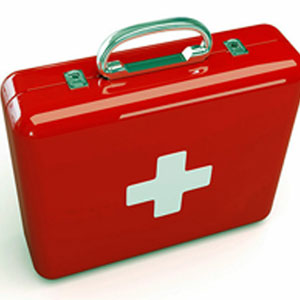How to Treat Injuries at Home
 We all have our household ways of treating minor injuries. But when was the last time you heard from a physician on how best to treat these?
We all have our household ways of treating minor injuries. But when was the last time you heard from a physician on how best to treat these?Growing up in a village in Africa, we treated most injuries at home with simple remedies. Cuts were usually treated with water and soap and wrapped with a clean cotton cloth that was reused after being washed in boiling hot water and air-dried until it was crisp. It is good to know what you can do at home in the event of an injury.
Cuts and bruisesOnce an injury occurs, the body’s natural response is to form a clot and to invite fighter white cells toward off infectious agents from entering the insulted skin tissues. It is common to see some fluids to exude from the cut. This is a normal response and is not to be mistaken for pus, which is a sign of active infection and requires a visit to the doctor. After a cut or bruise, a fever or red streaking or bleeding that is not controlled is a sign to visit the doctor.
Even today medical advice is to clean a cut or bruise with running cold water and wash it with soapy water. It is better to avoid applying soap directly because it may cause marked irritation. Wounds and cuts should be wrapped up to avoid the entry of bacteria. In most people with healthy immune responses, wounds heal with daily soap water washes when the clot is not interrupted.
A visit to the doctor becomes necessary if the bruise or cut appears deep where muscle and tendons are injured and yellowish fat is seen. Similarly, if a gash is longer than half an inch, that may herald a need for a stitch or two to seal the skin tight, to enhance healing, and to keep infection from setting in. All doctors will advise wounds to be left closed with gauze held firmly with an ace bandage or a safety pin. Gauze is preferable to cotton balls or batting, whose fibers might stick to the wound. Dettol is a favorite in many Indian households as an antiseptic disinfectant and works quite well, if you overlook that it may be more harsh and irritating than an ointment. If you’re looking for a more gentle way to disinfect, go for an ointment.
A dab of an antimicrobial agent such as Polysporin or Neosporin or a highly diluted peroxide may promote a sterile environment, particularly if the wound is on a mobile area such as a joint, or if the patient’s immunity is compromised by leukemia, diabetes, chemotherapy, age or HIV/AIDS. Grandma often used a dab of ghee or honey. I am unclear as to the science behind this, but I tend to believe that the thick layer must form a barrier of some sort against bacteria, and research is being conducted on the use of honey. In some areas of India, people use various other home remedies such as banana paste, burnt mango leaves and curry leaves.
SprainsA sprain is best managed with immediate application of ice. Most sprains heal with elevation, a pain killer such as over-the-counter Ibuprofen, and some bed rest with the limb elevated. An ace bandage to provide additional support will bring more relief from pain. If yours is a household with young children, have a pair of crutches handy! Injured limbs or joints heal faster without the extra weight on them. Should the joint or limb continue to swell after 24 hours, make sure to visit the doctor. A loss of sensation indicates a bigger problem and may require immediate attention. When I was growing up, Doctor Grandma was quick to prepare her cumin-and-flour homemade cast.
It is essential for every household to have an easily accessible first-aid kit. Make sure your first-aid kit is stocked for emergencies. At your next doctor visit consider getting a tetanus shot—it may save you a visit to the urgent care center. When in doubt it is best to give your doctor a call.[Gulshan Harjee, M.D., is a board certified internist in private practice with an emphasis on prevention. Please email your health and medical questions for consideration in this column to: gharjee@comcast.net. The material in this column is of a general nature, and must not be construed as specific medical advice. This column rotates monthly along with the Fitness Lifestyle column by Aarti Patel.]
Enjoyed reading Khabar magazine? Subscribe to Khabar and get a full digital copy of this Indian-American community magazine.
blog comments powered by Disqus










